Great shot of a pair of Curtiss SOC Seagulls at rest
Battleship
What’cha doin’ today?

Oh, just hanging around…
Operation Detachment D-3 + 75 years
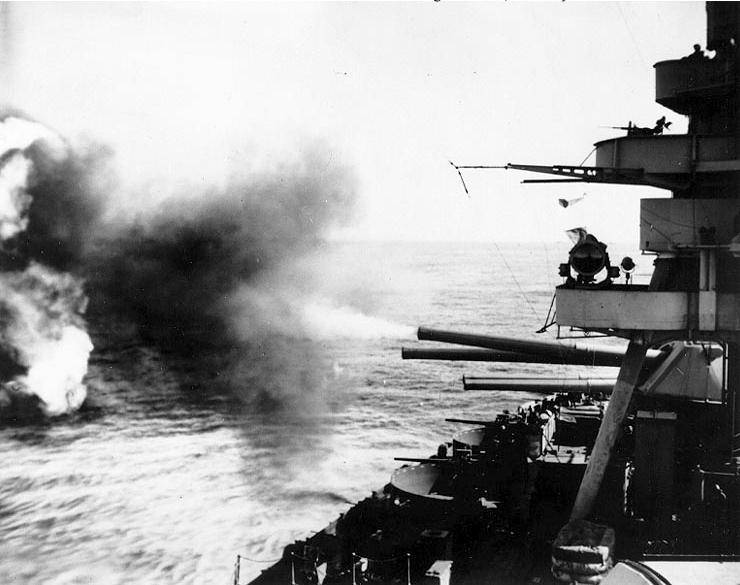
USS New York softening up a target on Iwo Jima with her 14″ main guns 16 February 1945 (D minus 3)
77 years ago today – HMS Hood sunk during the Battle of Denmark Strait
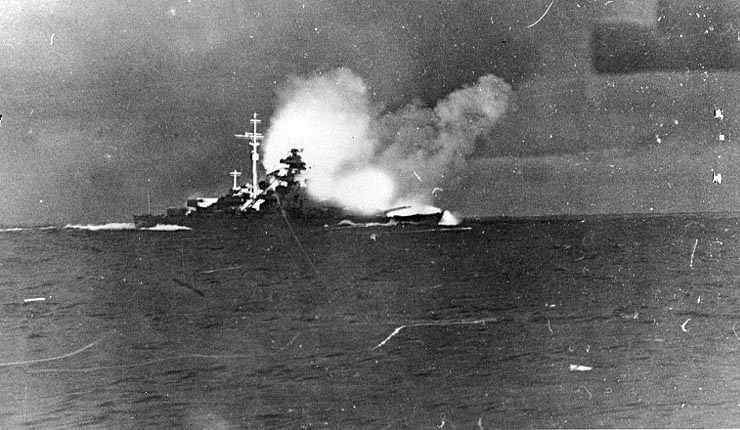
Bismarck firing on HMS Hood and HMS Prince of Wales during the Battle of Denmark Strait 24MAY41 photographed from Prinz Eugen

Smoke from HMS Hood immediately after an explosion during the Battle of Denmark Strait 24MAY41
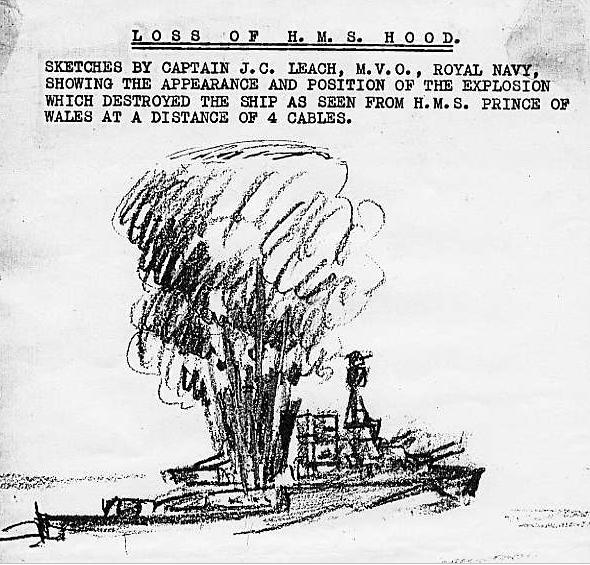
A sketch prepared by Captain JC Leach (commanding HMS Prince of Wales) for the 2nd Board of Enquiry, 1941. The sketch represents the column of smoke or flame that erupted from the vicinity of the mainmast immediately before a huge detonation which obliterated the after part of the ship from view. This phenomenon is believed to have been the result of a cordite fire venting through the engine-room ventilators
At 06:00, Holland ordered his force to turn once again to port to ensure that the aft main guns on both Hood and Prince of Wales could bear on the German ships; during the turn, a salvo from Bismarck, fired from about 9 mi (7.8 nmi; 14 km), was seen by men aboard Prince of Wales to straddle Hood abreast her mainmast. It is likely that one 38 cm (15 in) shell struck somewhere between Hood‘s mainmast and “X” turret aft of the mast. A huge pillar of flame that shot upward ‘like a giant blowtorch,’ in the vicinity of the mainmast, followed by an explosion that destroyed a large portion of the ship from amidships clear to the rear of “Y” turret, blowing both after turrets into the sea. The ship broke in two and the stern fell away and sank. Ted Briggs, one of the survivors, claimed Hood heeled to 30 degrees at which point ‘we knew she just wasn’t coming back’. The bow rose clear of the water, pointed upward, pivoted about and sank shortly after the stern. “A” turret fired a salvo while in this upright position, possibly from the doomed gun crew, just before the bow section sank.[nb 4] Splinters rained down on Prince of Wales .5 mi (0.43 nmi; 0.80 km) away. Hood sank in about three minutes with 1,415 members of the crew. Only Ted Briggs, Bob Tilburn and Bill Dundas survived to be rescued two hours later by the destroyer HMS Electra.
The Admiralty later concluded that the most likely explanation for the loss of Hood was a penetration of her magazines by a 38 cm (15 in) shell from Bismarck, causing the explosion. Recent research with submersible craft suggests that the initial explosion was in the aft 4 in (100 mm) magazine and that it spread to the 15 in (380 mm) magazines via the ammunition trunks. It has been suggested from examination of the wreckage, found in 2001, that the magazine explosion in the 4 in (100 mm) armament near the mainmast caused the vertical blast of flame seen there, and this in turn ignited the magazines of the aft 15 in (380 mm) guns that caused the explosion that wrecked the stern. This explosion might have travelled through the starboard fuel tanks, igniting the fuel oil there, setting off the forward magazines and completing the destruction of the ship.
The wreck of Hood revealed the bow section bereft of any structure. A huge section of her side is missing, from the ‘A’ barbette to the foredeck. The midship section had its plates curled outward. Moreover, the main parts of the forward structure, including the 600 long tons (610 t) conning tower, were found about 1.1 km (0.59 nmi; 0.68 mi) away from the main wreckage.[21] This has sparked theories that the 15 in (380 mm) forward magazines exploded as a result of the force, flames and pressure, caused by the detonation of the aft magazines.[22] However, a team of marine forensic scientists has found that implosion damage to the forward hull due to the rapid sinking of the Hood, is the most likely cause of the state of the forward hull, and they do not support any theory that the forward magazines exploded.[23]
If you have Amazon Prime, I found The Battle of Hood and Bismarck: The Sinking of History’s Greatest Warships to be pretty interesting.
I remember reading The Sinking of the Bismarck by William Shirer in 1979 when I was 8. I didn’t understand most of it but I liked the pictures and I thought the cover was cool yet sort of creepy. I think I need to track it down to add to the library.
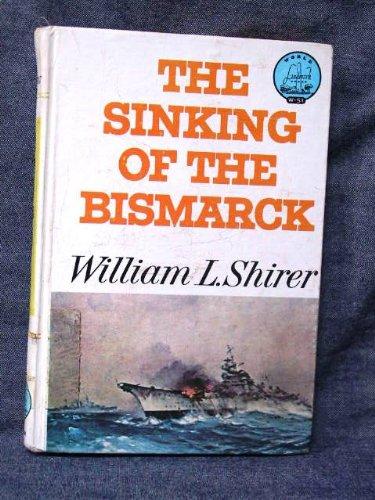
The Mk38 Gun Mount and Ballistics and Weapons Effectiveness Lessons from Pursuit of the Graf Spee, Part 1
This is the first of a 2 part post by Chuck Hill’s CG Blog. Part 1 uses The Battle of the River Plate to help explain the difficulties of just stopping a large ship, never mind actually sinking one.
Part 2 shows the potential weapons systems, tactics and difficulties today’s USCG could use to stop a large ship being used for nefarious purposes, either as a weapons carrier or as the actual weapon.
As a naval history buff Part 1 is the most interesting to me but both parts are well worth the time to read.

Photo: Heavy cruiser HMS Exeter seen after the battle, looking aft from the bow. Both forward twin 8″ gun turrets and the firecontrol system were disabled and the bridge destroyed by “splinters.”

Admiral Graf Spee in the English Channel in April 1939. U.S. Naval Historical Center Photograph # NH 89566.

Photo: After superstructure of Admiral Graf Spee showing 15 cm/55 and 10.5 cm/65 guns. Note the burned-out Arado Ar 196A-1 floatplane on the catapult and the after main-director rangefinder. Photograph taken at Montevideo, Uruguay in mid-December 1939, following the Battle of the River Plate. U.S. Naval Historical Center Photograph # NH 80976.
Introduction:
Note, this has been edited from the original, based on feedback particularly with regard to the ammunition remaining on Graf Spee after the engagement. I don’t believe the thrust of the post has been changed.
This is the first of two parts. Part one will tell a story. Part two will talk about the implications of lessons learned, applied to how the Coast Guard might deal with the threat of terrorists using a medium to large merchant ship to make an attack.
These are themes that will be discussed in part 2 before looking at specific tactics to make the best use of what we have. Hopefully you will see these illustrated in the following story.
- In comparing guns, at any given range, the longer ranged weapon generally enjoys an advantage in accuracy.
- It is very difficult to sink a ship by gunfire alone.
- Ships’ structure provide a degree of protection that makes it difficult to comprehensively target the crew of a ship without sinking the ship.
- It is difficult to forcibly stop a ship with gunfire alone.
- You can run out of ammunition before you accomplish your mission. The depth of your magazine may be important.
But first the story: The Mk38 Gun Mount and Ballistics and Weapons Effectiveness Lessons from Pursuit of the Graf Spee, Part 1
We’ve been fishing all day
And all we caught was this Kingfisher. And some netting…
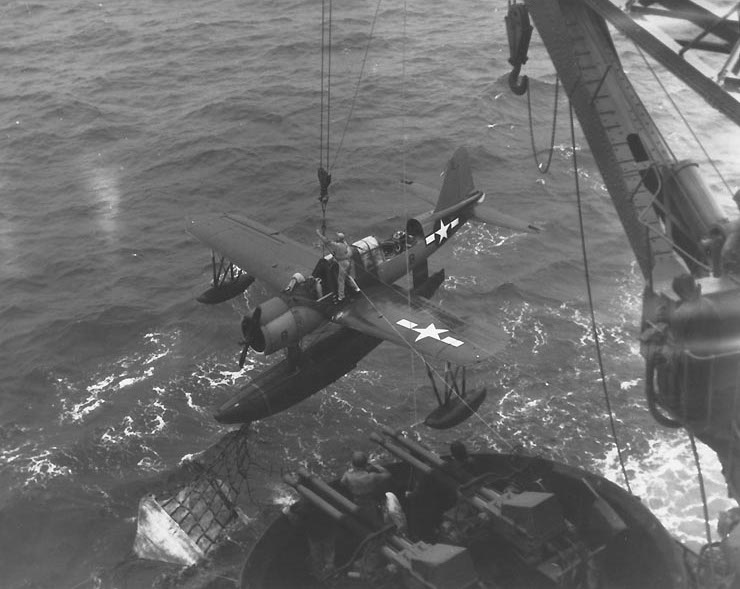
OS2U Kingfisher aircraft being recovered by battleship USS Texas, off Iwo Jima, at 1700 on 16 Feb 1945; note netting of recovery sled hooked on pontoon’s recovery hook
Source United States National Archives Identification Code 80-G-309140
Curtiss SC-1 Seahawk: Double Sadness.
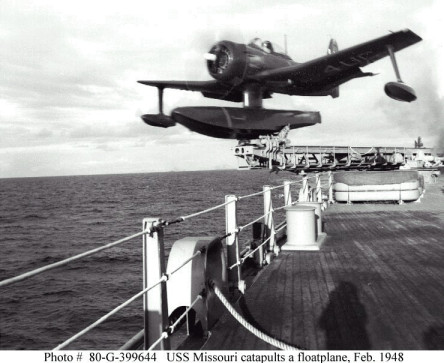
This cute single-seat scout seaplane was in fact one of the best -if no the best- American foatplane built durin’ WW2.In any event The Seahawk entered service at the end of 1944, too late show its true potential.Peace time and the arrival of the new versatile helicopters closed the glorious era of embarqued seaplanes.
More here: Curtiss SC-1 Seahawk: Double Sadness.
Making splinters, sawdust and toothpicks
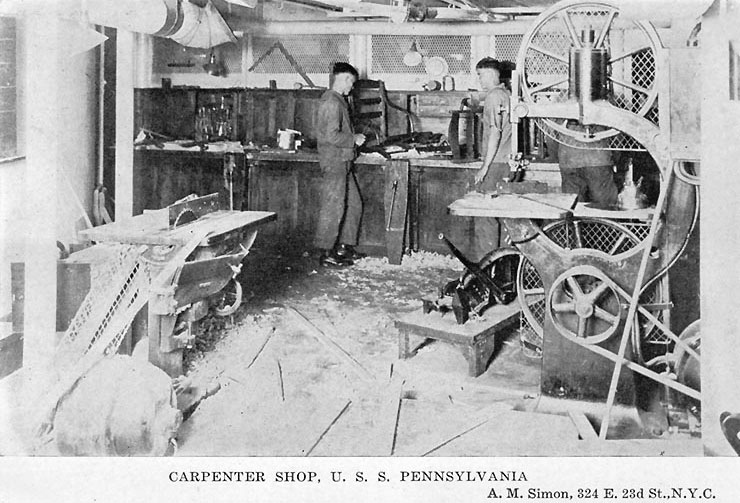
U.S.S. Pennsylvania’s carpenter shop as circa 1916-1918
I’m not sure what the piece of equipment is on the right. A band saw? I’d be happy with a wood working shop like that, steam powered or otherwise…
76 years ago today
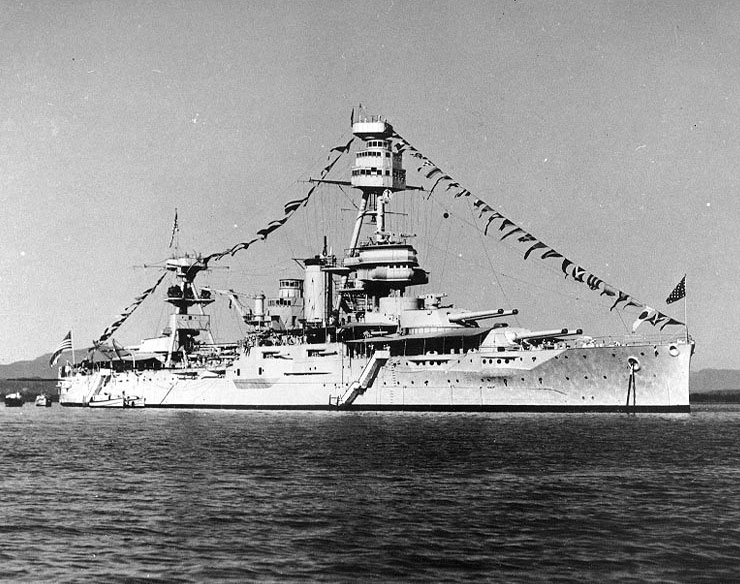
USS Texas on Navy Day, 27 Oct 1940
Source United States National Archives
Identification Code 80-G-464121
Notice a theme? LOL!
71 years ago today
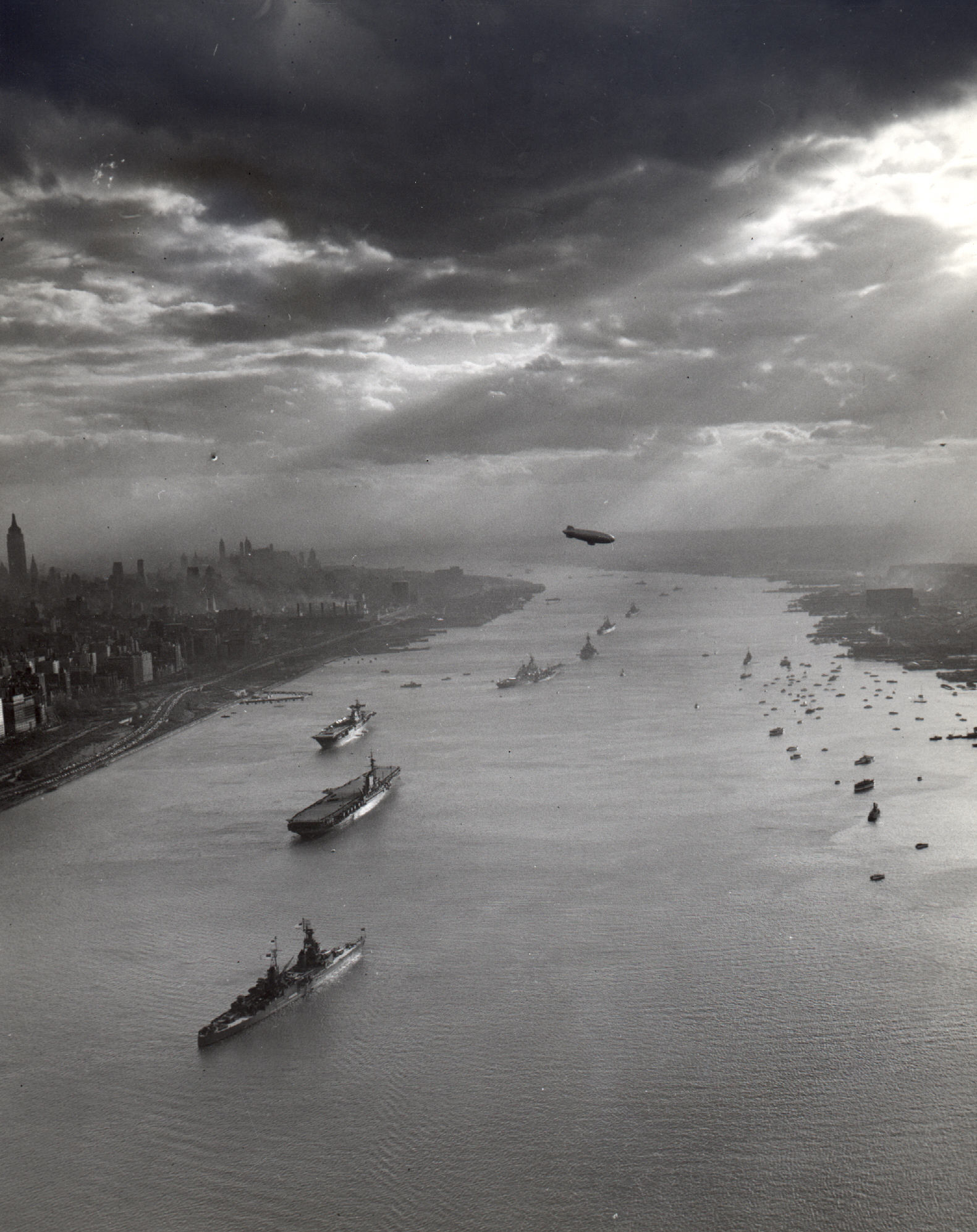
Tugboats and U.S. Navy warships pictured in the Hudson River with the New York City skyline in the background for the Navy Day celebrations on 27 October 1945. Visible in the foreground are the anchored warships USS Augusta (CA-31), USS Midway (CVB-41), USS Enterprise (CV-6), USS Missouri (BB-63), USS New York (BB-34), USS Helena (CA-75), and USS Macon (CA-132) U.S. Navy – U.S. Navy National Museum of Naval Aviation photo No. 2001.256.009
